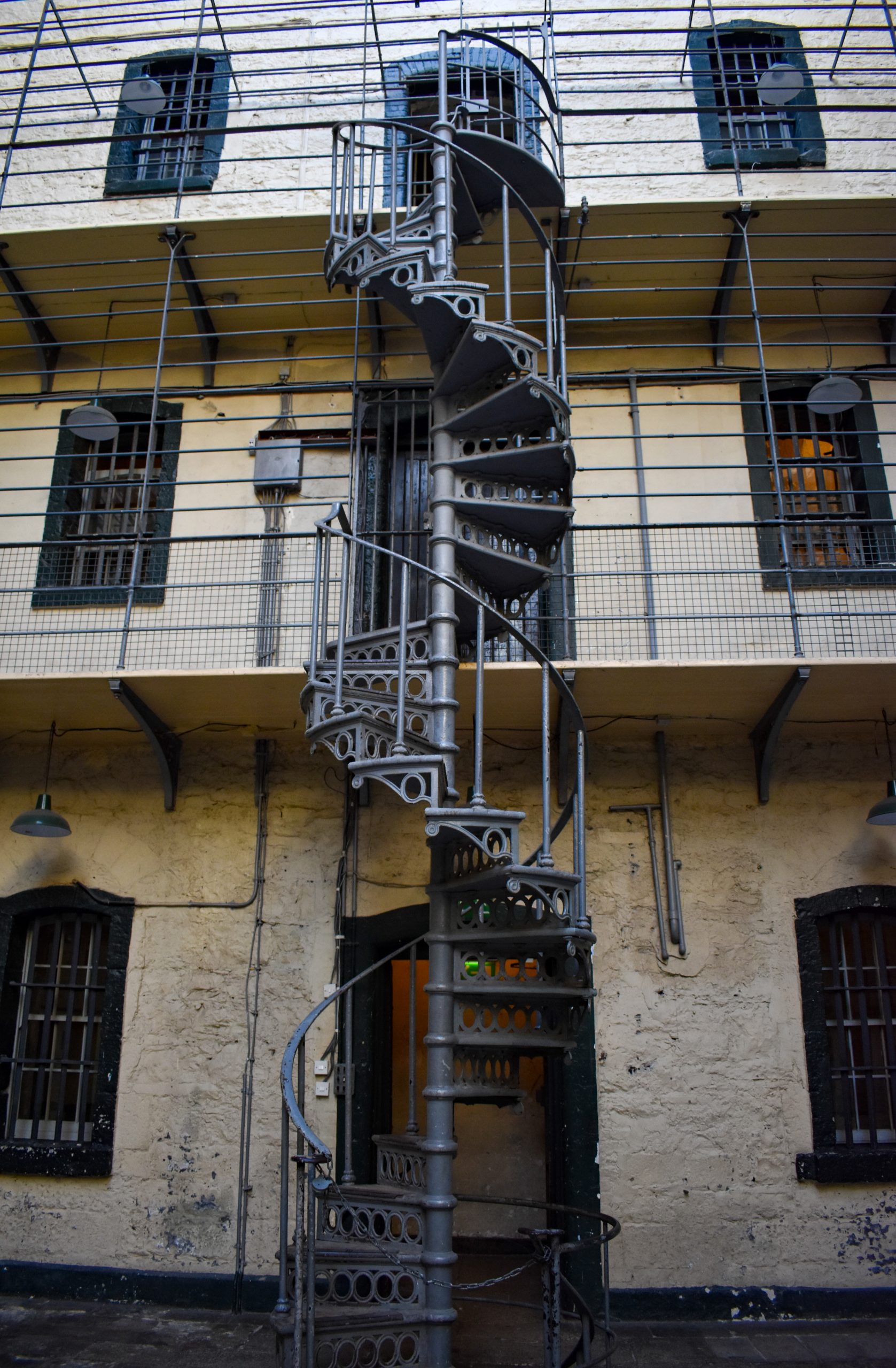This post may contain affiliate links, which means I’ll receive a commission if you purchase through my link, at no extra cost to you.
I never thought I’d be recommending a prison as the best thing to see in any city, however, Kilmainham Gaol is at the top of my list when it comes to Dublin, Ireland. Kilmainham Gaol, now a museum, opened in 1796 and was one of the most modern prisons in Ireland at the time. This prison played a large part in Ireland’s path to Independence and was eventually decommissioned in 1924 at the end of the Irish Civil War.

Tour guides take visitors through the mesmerizing history of the prison and the events leading up to Ireland’s Independence that occurred at Kilmainham Gaol. Surprisingly, the prison is beautiful, with the deliberate use of large skylights and windows with the belief that it was crucial to inmate reform, encouraging prisoners to turn heavenward. In stark contrast, there are 4 cellar-level areas below the stunning prison floor to punish certain prisoners with darkness and solidarity.
Kilmainham Gaol History

Kilmainham Gaol replaced an earlier prison that was located nearby in response to overcrowding in the 18th century. Construction began on the “New Gaol” in 1786 which was designed by John Trail and cost the Grand Jury of the County of Dublin a total of £22,000. This new site sat higher on the hill, which allowed for better drainage, thus allowing fresher air to circulate through the Gaol. The original gaol was dark and unforgiving, with toilet facilities being pots inside cells, and light and warmth only coming from candles. The Prison Reform Movement, led by John Howard, protested the typical atmosphere of gaols and pushed for single cells and facilities for hygiene and health. This change was exemplified in the late 1850s when the East Wing was replaced on the New Gaol. Architect John McCurdy, a freemason and college architect of Trinity College of Dublin, won the advertised design competition, and four years later, the Victorian age ideology of prison architecture being crucial to inmate reform, was showcased. The East Wing illustrated the panopticon concept, with all 96 cells viewable from a central observation area.
The main entrance of Kilmainham Gaol is an intimidating doorway, where five large shapes tower. These shapes are said to be dragons, demons, serpents, and hydra which represent the five worst crimes: murder, rape, theft, treason, and piracy. During the famine years from 1845-1852, The Vagrancy Act of 1847 compelled the arrests of beggars, causing handfuls of citizens to resort to petty crimes purely to gain entry to the Gaol for the chance to have a meal. On top of this, the gaol was a holding depot for convicts sentenced to transportation to Australia. This created extreme overcrowding, along with disease, poor hygiene, and diminishing health. All efforts within the Prison Reform Act disappeared as the prison was forced to move away from single cells and turned into a last resort of combining male, female, and children inmates. The cells that were intended to hold one person ended up holding as many as five at a time.

From 1691 to 1801, this period was known as Protestant Ascendency. Meaning the political, economic, and social dominance handed down from Britain. The Society of United Irishmen was Presbyterian based and formed subsequent to the French Revolution with the goal of equal representation in national government. The founder, Henry Joy McCracken, was the first political prisoner of Kilmainham in 1796 and was hanged two years later. 100 years later the United Irishmen Society dissolved after a bloody battle.
In 1800, the Act of Union was passed which formed a new country, The United Kingdom of Great Britain and Ireland. All regional parliaments were abolished and the entire UK now ruled from a central London parliament. The largest notable change in Ireland was the inability to pass laws on their own.
With the work of Robert Emmet and his brother Thomas, the United Irishmen Society was reorganized and a new plan put into place – a rebellion. The brothers secretly built up a large supply of arsenals but when reinforcements arrived, they saw that the supply was nearly all explosives and very few guns. They turned away, asking Robert to call off the rebellion. Robert secured £500 to purchase guns, however, the man he sent to buy the guns disappeared with the money.
On the day of the battle, Robert expected 2,000 men but less than 100 showed up, and on top of this, the men began drinking at the local taverns. Pushing forward, he led the drunk men to the Castle in hopes that the community would support him. Finally, Robert saw no option but to end the rebellion and he left the drunken men. An estimated 50 people died that night and the leaders of the rebellion were brought to Kilmainham Gaol and sentenced to be hanged, drawn, and quartered. Robert Emmet went into hiding but was quickly betrayed by an informer. Robert was hanged and beheaded in September 1803.
The Catholic Relief Act of 1829 repealed the Test Acts from the mid to late 1600s, permitting members of the Catholic Church to now sit in the UK Parliament, along with several rights that were previously illegal such as owning land, possessing weapons, studying law and medicine, and speaking and reading Gaelic, for example. The Test Acts were several English penal laws that sought conformance with the Church of England. Daniel O’Connell became the first Catholic parliament member to be seated since 1689, and during his service he campaigned to repeal the Act of Union in order to revert Ireland to a self-governing nation.

Another rebellion formed by the Irish Republican Brotherhood, also known as “Fenians,” which took place in 1867. This was a short stint due to poor planning, in an attempt for nationwide insurrection. Most of the leaders of this rebellion were arrested and imprisoned at Kilmainham. Following this uprising, Kilmainham was cleared of common prisoners and security was strengthened.
In 1881, Kilmainham became an all-male prison. Surprisingly, women made up a significant portion of the gaol until this. The same year, several members of parliament, including Charles Stewart Parnell, the leader of the Irish Parliamentary Party at Westminster, were imprisoned in Kilmainham after they openly rejected the Land Act introduced by the British government. The Land Act of 1881 gave tenants more power through rent control, disallowing eviction if rent was paid, and even the ability to sue landlords. Charles was imprisoned in Kilmainham for 8 months. Shortly after his release, 2 officials of the British government in Ireland were assassinated by members of a group called, “The Invincibles,” a branch of the Fenians. Five members of this group were hanged at Kilmainham in 1883 for their role in the assassinations.

In 1901, the gaol closed as a convict prison. It was handed over to the British Army, who used it as a military detention center, housing political prisoners. In 1916, Easter Monday, members of the Irish Volunteers and Irish Citizen Army seized a series of strategic buildings in Dublin, declaring the Irish Republic. The Rising lasted a week before the rebels surrendered and Kilmainham Gaol was reopened to house all those arrested in association. The next month, 14 leaders were executed in the Stonebreakers’ Yard, also known as the hard labor yard of Kilmainham. The remaining prisoners were released in 1917.
In 1918, the largest Irish republican political party won the General Election in a landslide victory. In 1919, the party refused to join Westminster and established their own parliament, the Dáil. This same year the War of Independence, also known as the Anglo-Irish War, began and Kilmainham was used by the British government to hold captured members of the Irish Republican Army until the truce of 1921. The Anglo-Irish Treaty was signed in London in 1921, and required an oath of allegiance to the British monarch, which divided Sinn Féin, an Irish republican and democratic socialist political party. Rather than Ireland becoming an independent nation, it would be an autonomous domain of the British Empire. This divide led to the Irish Civil War that began in 1922, when 200 anti-treaty Irish Republic Army members stood their ground within several key buildings in Dublin.
Those in favor of the treaty became known as the Free State. Three months into the war, additional legislation was passed by the Free State that gave them more power. They had the authority to impose life sentences and the death penalty. Near the end of the war, this escalated when the Free State started executing Irish Republic prisoners without authorization. An estimated 12,000 Irish Republic prisoners lost their lives during the war. Near the end of 1922, a prominent member of the Free State was assassinated by the Irish Republic, causing the Free State to retaliate by executing four Irish Republicans that were imprisoned. Eventually, the Irish Republic had no choice but to succumb to the Free State. In 1923, Kilmainham Gaol closed its doors for good.

It was not until 1949 that Ireland became the Republic of Ireland, with power now being vested in the President of Ireland rather than the king.
Because the prison was a site of suffering and persecution there was no interest in preserving it. Kilmainham Gaol sat empty until the Kilmainham Gaol Restoration Committee, made up of mostly veterans from the 1916-1923 era, came about in 1960 with the goal of preserving the site as a monument of Irish nationalism. Kilmainham Gaol opened as a museum in 1966, the 50th anniversary of the Rising. Kilmainham Gaol represents the hundreds of years of struggle that lead up to Ireland’s independence, which is why it is such an important stop when visiting Dublin.
How To Visit
Kilmainham Gaol can only be accessed by guided tour, which are available year-round and last 90-minutes. Tickets can be purchased 28 days in advance, and I highly recommended reserving a ticket then. Tickets sell out quickly and waiting until the day of your visit will probably result in no visit at all.
Tickets be reserved here and are priced at:
Adults: €8
Seniors: €6
Students/Children (12-17): €4
Children under 11: Free
Family and group tickets are also available
Note: There is no designated parking for Kilmainham Gaol, but there is limited paid street parking available as well as additional parking at the Irish Museum of Modern Art/Royal Hospital Kilmainham that can be accessed via East Gate, Military Road.
The guided tour is not wheelchair friendly, however, wheelchair users or visitors with mobility impairments can organize a ground floor tour.
Address: Kilmainham Goal Inchicore Rd, Dublin, Co. IE, Ireland
myVEGAS Rewards Comp Calendars (August- December 2025)
Check out the 2025 myVegas Hotel Comp Calendars for Mandalay Bay, Luxor, Park MGM, MGM Grand, Excalibur, and New York New York, Bellagio, and Aria
Access to 360+ Gardens Across North America: American Horticultural Society Membership (2025)
Discover the wonders of nature through the American Horticultural Society’s (AHS) Reciprocal Admissions Program Membership, offering exclusive access to a remarkable network of over 360 gardens across North America, including 317 paid gardens with complimentary entry.
myVEGAS Rewards Comp Calendars (January – July 2025)
Check out the 2025 January – July myVegas Hotel Comp Calendars for Mandalay Bay, Luxor, Park MGM, MGM Grand, Excalibur, and New York New York, Bellagio, and Aria





Interesting history of the Kilmainham Gaol prison. It reminds me of the tour of Alcatraz in San Francisco.
Did not see this when I visited Dublin but definitely will next time. Thanks for sharing.